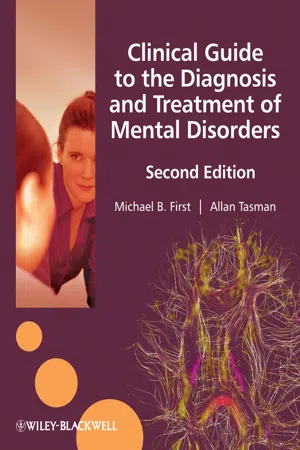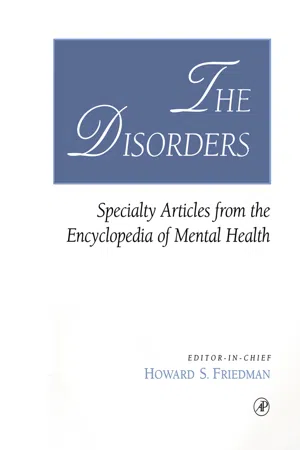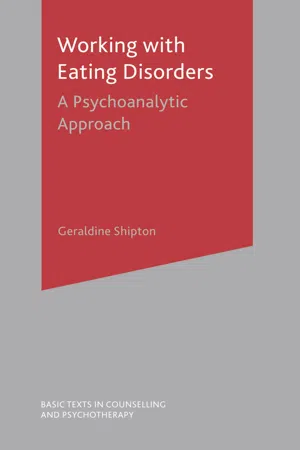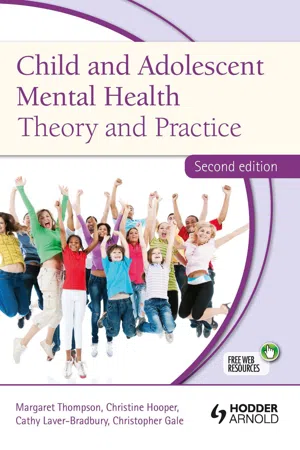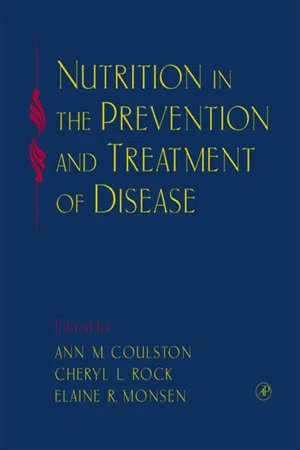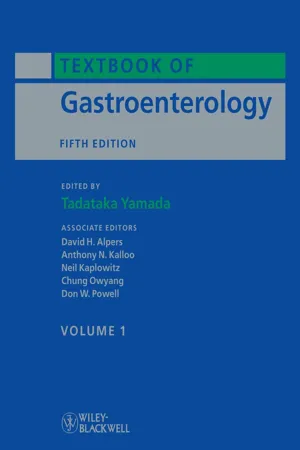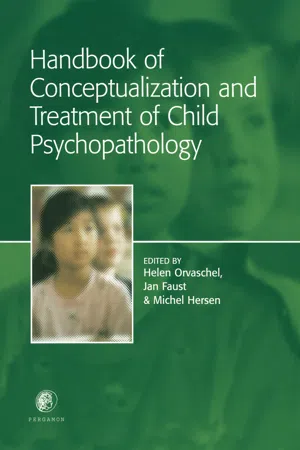Psychology
Bulimia Nervosa
Bulimia nervosa is an eating disorder characterized by recurrent episodes of binge eating followed by compensatory behaviors such as vomiting, fasting, or excessive exercise. Individuals with bulimia often have a distorted body image and intense fear of gaining weight. This disorder can have serious physical and psychological consequences if left untreated.
Written by Perlego with AI-assistance
Related key terms
1 of 5
12 Key excerpts on "Bulimia Nervosa"
- Michael B. First, Allan Tasman(Authors)
- 2013(Publication Date)
- Wiley(Publisher)
Bulimia Nervosa Definition The salient behavioral disturbance of Bulimia Nervosa is the occurrence of episodes of binge-eating. The individual consumes an amount of food that is unusually large considering the circumstances under which it was eaten. The available data do not suggest that there is a sharp dividing line between the size of binge-eating episodes and the size of other meals. Episodes of binge- eating are associated, by definition, with a sense of loss of control. Once the eating has begun, the individual feels unable to stop until an excessive amount has been consumed. After overeating, individuals with Bulimia Nervosa engage in some form of inappropriate behavior in an attempt to avoid weight gain. Most patients who present to eating disorders clinics with this syndrome report self-induced vomiting or the abuse of laxatives. Other methods include misusing diuretics, fasting for long periods, and exercising extensively after eating binges. The DSM-IV-TR criteria require that the overeating episodes and the compensatory behaviors both occur at least twice a week for three months to merit a diagnosis of Bulimia Nervosa. This criterion, although useful in preventing the diagnostic label from being applied to individuals who only rarely have difficulty with binge-eating, is clearly an arbitrary one. Criterion D in the DSM-IV-TR definition of Bulimia Nervosa requires that individuals with Bulimia Nervosa exhibit an overconcern with body shape and weight. In the DSM-IV-TR nomenclature, the diagnosis of Bulimia Nervosa is not given to individuals with Anorexia Nervosa. Individuals with Anorexia Nervosa who recurrently engage in binge-eating or purging behavior should be given the diagnosis of Anorexia Nervosa, Binge-eating/Purging Type, rather than an additional diagnosis of Bulimia Nervosa.- eBook - PDF
The Disorders
Specialty Articles from the Encyclopedia of Mental Health
- Howard S. Friedman(Author)
- 2001(Publication Date)
- Academic Press(Publisher)
Anorexia Nervosaand BulimiaNervosa Melissa Peders0nMusseU University of St. Thomas University of Minnesota James E. Mitchell University of North Dakota Medical School Neuropsychiatric Research Institute I. Overview of Eating Disorder Terms II. Continuum of Health Related to Eating Disorders III. Diagnostic Criteria IV. Epidemiology V. Psychological and Social Impairment VI. Medical Complications VII. Detection and Assessment VIII. Treatment IX. Prevention X. Summary Anorexia Nervosa A type of eating disorder asso- ciated with failure to maintain a minimally healthy body weight. Binge Eating Eating large amounts of food in a dis- crete period of time accompanied by a sense of loss of control of food intake. Bulimia Nervosa A type of eating disorder involv- ing recurrent episodes of binge eating and compen- satory behaviors (e.g., purging, fasting, or excessive exercise). Eating Disorder A category of psychiatric disorders involving disturbances in eating patterns and attitudes toward food and body image. Purging A method of compensating for dietary in- take, most commonly by self-induced vomiting, laxa- tive abuse, or diuretic abuse. ANOREXIA NERVOSA AND Bulimia Nervosa are two of the most commonly recognized eating dis- orders. The term eating disorder encompasses a va- riety of psychological/psychiatric disorders involving 57 disturbed eating patterns and attitudes toward food and body image. Unhealthy weight control practices and intense body image distortion or disparagement are central features of eating disorders. I. OVERVIEW OF EATING DISORDER TERMS The word nervosa indicates that each of these con- ditions is a nervous disorder. Psychological difficul- ties are likely to be involved in the development of these disorders, and also are likely to be exacerbated by the eating-disordered behavior. Anorexia means lack of appetite. The hallmark feature of anorexia nervosa (AN) is failure to maintain a minimally nor- mal body weight. - eBook - ePub
Working With Eating Disorders
A Psychoanalytic Approach
- Geraldine Shipton(Author)
- 2017(Publication Date)
- Bloomsbury Academic(Publisher)
4BULIMIA NERVOSA
Bulimia Nervosa was not fully distinguished from anorexia as a clinical condition, until Gerald Russell published a paper on it in the UK in 1979, though it has been associated with anorexia since the early writings of Gull (1873). Bulimia Nervosa has been described as ‘a syndrome characterised by repeated bouts of overeating and an excessive preoccupation with the control of body weight, leading to a pattern of overeating followed by vomiting or use of purgatives … often but not always with a history of an earlier episode of anorexia nervosa’ (ICD-10, p. 352). For a diagnosis to be made, the following should all be present:Persistent preoccupation with eating and an irresistible craving for food with bouts of overeating in which large amounts of food are consumed in a short period of time.Behaviour designed to counteract the effects of the above by using one or more of the following: self-induced vomiting, purging, alternating periods of starvation, use of appetite suppressants, thyroid preparations or diuretics.A morbid fear of fatness with a low target weight set.Another variant, atypical Bulimia Nervosa, has been distinguished as similar but ‘without a significant weight change or the typical over concern about body shape and weight may be absent’ (ICD-10, p. 353). The Royal College of Psychiatrists (2000) commissioned a survey of services for people with eating disorders and found ‘many cases represent intermediate forms’ (2000: 11) and would not fit neatly into their categories of anorexia nervosa, Bulimia Nervosa and binge eating disorder. This latter is ‘bingeing without compensatory behaviour’, and is associated with obesity and increased mortality rate.People who binge and vomit or who purge may also have enlarged salivary glands, electrolyte imbalance which can predispose them to fits and cramps, and they may have damaged the enamel on their teeth by vomiting. They may also develop long-term constipation, though short-term they are likely to have stomach cramps and diarrhoea. If they restrict their food intake too, they may have the additional symptoms outlined in Chapter 3 - eBook - PDF
What Works for Whom?, Second Edition
A Critical Review of Psychotherapy Research
- Anthony Roth, Peter Fonagy(Authors)
- 2013(Publication Date)
- The Guilford Press(Publisher)
C H A P T E R 9 EATING DISORDERS Anorexia Nervosa, Bulimia Nervosa, and Binge-Eating Disorder DEFINITIONS DSM-IV-TR assumes a diagnostic primacy for anorexia nervosa; on this basis, a diagnosis of Bulimia Nervosa can only be applied in the absence of anorexic features. Anorexia Nervosa The essential feature of this disorder is a refusal to maintain body weight at or above a minimally “normal” body weight; this is defined as a body weight 15% below that expected for the individual’s age and height. To meet diagnostic criteria, there must also be an intense fear of becoming fat, even though underweight; a severe restriction of food intake, often with excessive exercising, in order to achieve weight loss; a disturbance in the way in which body weight or shape is experienced, and an undue influ- ence of body weight or shape on self-evaluation; and (in postmenarcheal women) amenorrhea. There are two subtypes of anorexia nervosa—binge-eating/purging type, in which there is regular binge eating or purging (self-induced vomit- ing, or use of laxatives or diuretics), and restricting type, in which these behaviors are not present. 236 Bulimia Nervosa The main feature of this disorder is recurrent episodes of binge eating asso- ciated with a lack of control over eating behavior during the binges. Self- induced vomiting, use of laxatives or diuretics, and strict dieting or ex- cessive exercise are often associated features, together with a persistent preoccupation with body size and shape. At least two binges a week over a period of 3 months are required to make this diagnosis. As with anorexia nervosa, self-evaluation is excessively linked to ideas about body weight and shape. DSM-IV-TR subtypes Bulimia Nervosa to purging type, in which vom- iting or purging occurs, or nonpurging type, in which excessive fasting or exercise occurs but without purging. - eBook - PDF
Child and Adolescent Mental Health
Theory and Practice, Second Edition
- Christine Hooper, Margaret Thompson, Catherine Laver-Bradbury, Chris Gale, Christine Hooper(Authors)
- 2012(Publication Date)
- CRC Press(Publisher)
This does not account for those young people who do not access services to manage their illness. Some may cease the restricting behaviour but go on to develop Bulimia Nervosa. Bulimia Nervosa Bulimia Nervosa refers to episodes of uncontrolled excessive eating called ‘binges’ followed by vomiting or the use of purgatives. The onset of Bulimia Nervosa is usually in late adolescence, often after a period of concern about weight and shape; following a period of food restrictions. Twenty-five per cent of patients have a past history of Anorexia. The number of episodes of bingeing increases over time, returning the weight to near normal. Diagnosis ICD-10 (WHO, 1992) criteria for Bulimia Nervosa: • A persistent preoccupation with eating and an irresistible craving for food; the patient succumbs to episodes of overeating in which large amounts of food are consumed in short periods of time. • The patient attempts to counteract the ‘fattening’ effects of food by one or more of 282 Eating disorders the following: self-induced vomiting, purgative abuse, alternating periods of starvation, use of drugs such as appetite suppressants, thyroid preparations or diuretics. When Bulimia Nervosa occurs in diabetic patients, they may choose to neglect their insulin treatment. • The psychopathology consists of a morbid dread of fatness. The patient sets him/herself a sharply defined weight threshold, well below the pre-morbid weight that constitutes the optimum or healthy weight in the opinion of the physician. There is often, but not always, a history of an earlier episode of Anorexia nervosa (in 25 per cent), the interval between the two disorders ranging from a few months to several years. The earlier episode may have been fully expressed, or may have assumed a minor cryptic form with moderate loss of weight and/or a transient phase of amenorrhoea. - Carol J. Boushey, Ann M. Coulston, Cheryl L. Rock, Elaine Monsen(Authors)
- 2001(Publication Date)
- Academic Press(Publisher)
CHAPTER 43 Eating Disorders: Anorexia Nervosa, Bulimia Nervosa, and Binge Eating DisorderCHERYL L. ROCK1 ,1 University of California at San Diego, La Jolla, CaliforniaWALTER H. KAYE2 ,2 University of Pittsburgh Medical Center, Pittsburgh, PennsylvaniaI. INTRODUCTION
As a general theme, the eating disorders are characterized by abnormal eating patterns and cognitive distortions related to food and weight, which, in turn, result in adverse effects on nutritional status, medical complications, and impaired health status and function. Diagnostic criteria for the eating disorders and the approaches to management have evolved through various stages during the past several decades, and research efforts continue to increase knowledge of the biological and behavioral aspects of eating pathology.II. DEFINITIONS AND DIAGNOSTIC CRITERIA
A. Diagnostic Criteria and Distinguishing CharacteristicsClinical diagnosis of these disorders is based on the psychological, behavioral, and physiological characteristics described by the Diagnostic and Statistical Manual of Mental Disorders, fourth edition (DSM-IV), criteria [1 ]. Current DSM-IV criteria for anorexia nervosa, Bulimia Nervosa, eating disorder not otherwise specified, and binge eating disorder are listed in Table 1 . For anorexia nervosa, the diagnostic criteria specify body weight <85% of that expected based on age and height (with the latter cutpoint typically interpreted as being a body mass index ≤ 17.5 kg/m2- eBook - PDF
Psychosomatics
The Uses of Psychotherapy
- Peter Shoenberg(Author)
- 2017(Publication Date)
- Red Globe Press(Publisher)
Rodin argues that binge-eating and purging are often motivated by an attempt to regulate intolerable affect states. Often the lives of such patients are chaotic with troublesome interpersonal rela-tionships and additional impulsive behaviours which are self-destructive. They may be anxious and suffer with low self-esteem. There is a high prevalence of mood disorder and substance abuse and compulsive stealing may also occur (Halmi, 2000). The underlying psychopathology is often like that of anorexia nervosa. Fear of fatness is in conflict with an uncontrollable desire to eat excessively. Conflicts about sexuality and feminin-ity, a disturbed body image and underlying depression, guilt and anxiety are common findings. The secret and solitary bingeing episodes bring about temporary relief but leave the patient feeling more guilty and depressed afterwards. As bingeing ceases during therapy, patients may experience a period of depression (Wolff and Shoenberg, 1990). Medical Complications (Ha/mi, 2000) 1 The exposure to the gastric juices by vomiting causes severe erosion of the teeth; 2 Parotid gland enlargement; 3 Acute dilatation of the stomach and oesophageal tears; 4 Intoxication with laxative ipecac may cause cardiomyo-pathy (disease of the heart muscles), leading to cardiac failure; 5 Hypokalaemic alkalosis, as seen in the bulaemic form of anorexia nervosa. ANOREXIA NERVOSA AND Bulimia Nervosa 111 Treatment of Bulmia Nervosa Cognitive behaviour therapy (CBT) has been studied in 35 con-trolled psychosocial studies: it has been found that up to 40-50 per cent of patients have abstained from binge-eating and purging by the end of a 16-20 week treatment period with improvement through reduced binge-eating and purging in 75-95 per cent of patients. CBT also helps with the depression. Thirty per cent of patients without an initial improvement showed a full recovery at one year. - eBook - PDF
- Nash, Joyce D.(Authors)
- 1999(Publication Date)
- New Harbinger Publications(Publisher)
example, vomiting, abuse of laxatives) that characterize Bulimia Nervosa. Unofficially termed “compulsive overeating” or “emotional eating,” BED affects nearly 2.0 percent of the population. 1 (Rates are similar among both white men and women and black women.) Binge eating disorder is often accompanied by over- weight. Some 8.0 percent of obese women in the community may suffer from BED, and an estimated 2.0 percent to 5.0 percent of all adults, regardless of weight, do as well. 2 Between 25.0 percent and 35.0 percent of those who seek treatment for obesity have BED. 3 The more severely overweight a person is, the more likely it is that binge eating is a problem. 4 Binge eating disorder affects slightly more women than men, exhibiting a ratio of 3:2. Meredith. Meredith, a twenty-eight-year-old nurse, described her eating problem. “I don’t eat breakfast but sometimes I’ll eat a reasonable lunch—usually half a bagel, maybe with low fat cream cheese. Sometimes I allow myself fat-free potato chips as a snack and I’ll eat fat-free cookies. Even so, I’m frequently hungry. There’s always food to eat on the ward, but finding the time to eat a regular meal is hard. There’s always a crisis or something that needs to be done immediately. Generally I try to stay away from the yummies people are always bringing in, but sometimes it gets the best of me, especially if I’m tired or cranky. Once I eat some- thing, I figure that’s it. I may as well go all the way. I know I can get rid of the calories by purging. But I feel awful afterwards. I’m so ashamed of my eating; it just proves that I can’t do anything right.” Bulimia Meredith is bulimic. The defining feature of Bulimia Nervosa is binge eating followed by vomiting, laxative abuse, excessive exercising, or some other way of compensating for the calories consumed. Bulimics are usually normal weight, though they may be slightly overweight or underweight. - eBook - PDF
Eating Disorders in Adolescence
Anorexia and Bulimia Nervosa
- Hans-Christoph Steinhausen(Author)
- 2020(Publication Date)
- De Gruyter(Publisher)
A Population Study of Bulima Nervosa and Subclinical Eating Disorders in Adolescence Martine F. Flament, Sylvie Ledoux, Philippe Jeammet, Marie Choquet, and Yves Simon Bulimic behaviors have been reported in the psychiatric and psychoanalytic literature for more than a century. However, it was only in the late 1970s that Bulimia Nervosa was identified and described as a distinct clinical disorder occurring mainly in young women (Russell, 1979; Igoin, 1979). Most clinicians now agree on three core features of the disorder: bulimia is characterized by uncontrolled and recurrent eating binges in subjects who are, nevertheless, overly concerned about their weight and body shape; as a result, they are led to adopt extreme compensatory weight control strategies of purging type (self-induced vomiting, use of laxatives or diuretics) and/or restricting type (dieting, fasting, rigourous exercise). Clinical experience has shown that bulimic and associated problematic behaviors are often kept secret for many years, and patients only seek help when the disorder has reached unmanageable levels. By that time, the symptomatic behaviors are well entrenched, and associated difficulties and social incapacitation have begun to develop. Most patients come for treatment in their mid-twenties, whereas the disorder had started, on average, at around 18 years of age (Flament et al., in press). Therefore, the study of clinical and subclinical forms of Bulimia Nervosa in the general adolescent population should bring important information on the prevalence and clinical features of the disorder in its early stage. 22 M.F. Flament/S. Ledoux/Ph. Jeammet/M. Choquet/Y. Simon 1 Studies of the Epidemiology of Bulimia Nervosa in Adolescents We reviewed eighteen published studies on the prevalence and clinical features of Bulimia Nervosa in adolescents from the community. All have been conducted among secondary school students. - eBook - ePub
- Tadataka Yamada(Author)
- 2011(Publication Date)
- Wiley-Blackwell(Publisher)
This condition was first described as a clinical entity in 1979 [23]. In addition to excessive concern about weight or body shape, which is similar to AN, patients diagnosed with BN also have recurrent episodes of binge-eating followed by inappropriate compensatory activities, such as vomiting. Four diagnostic criteria for BN are listed in DSM-IV:- recurrent binge eating (at least twice per week for 3 months)
- recurrent purging, excessive exercise, or fasting (at least twice per week for 3 months)
- excessive concern about bodyweight or body shape
- the absence of anorexia nervosa (Table 103.1 ).
Although a common component, vomiting is not mandatory to the diagnosis. Other compensatory activities that may be employed in BN include abuse of laxatives, diuretics, or enemas, or excessive exercise or fasting. Because fasting behavior can be encountered in BN, just as binge-purge behavior can be seen in AN, the phenotypic expression of these two conditions can exhibit considerable overlap.Could anorexia nervosa and Bulimia Nervosa share an underlying pathophysiology?Bulimics and anorexics are different in one conspicuous way: bulimics are normal weight, whereas anorexics are underweight. In addition, cycles of binge eating and subsequent compensation, such as cathartic-induced purging and vomiting, are necessary for the diagnosis of BN. However, could this separation by phenotype be an artificial one? In her original description of AN, Bruch included binging and purging behavior as a part of the condition [22], and Russell presented bulimia as a special form of anorexia [23]. Could there be a common etiology?Table 103.1Diagnostic criteria for anorexia nervosa and Bulimia NervosaA. Anorexia nervosa1. Inability to maintain a minimally appropriate bodyweight, as indicated by bodyweight < 85% of expected for age 2. Intense fear of weight gain 3. Disturbance in the perception of one’s own body shape, size, and weight 4. Amenorrhea lasting for three consecutive months in females who are postmenarcheB. Bulimia Nervosa1. Recurrent episodes of binge eating as defined by eating an excessively large amount of food within a discrete period of time, with these episodes often associated with individuals feeling a lack of control over their eating - Helen Orvaschel, Michel Hersen, Jan Faust(Authors)
- 2001(Publication Date)
- Pergamon(Publisher)
Factors associated with poor prognosis were low Anorexkt Nervosa 309 initial weights and longer duration of these low weights, presence of bulimic symptoms such as binge/purge cycles and laxative abuse, and poor family relation- ships (Strober, et al., 1997). Summary Anorexia Nervosa affects approximately one percent of females and is an extre- mely protracted and deadly disorder. This chapter presents a multifactorial model that indicates the need for diverse treatments that address biological, intrapsychic, familial, and cultural factors. Of utmost importance is the timely restoration of health. The central difficulty in the treatment of Anorexia is that of motivating adolescents to decrease their drive for thinness and increase their motivation to attain health, an extremely difficult proposition. Psychological therapists have differed in their ideas about the underlying etiology of the eating disorder that directs the focus of intervention. Two treat- ment approaches are described: (1) the Narrative/Constructive approach, which focuses its intervention on the co-construction of meaning, with acknowledgment of the importance of cultural beliefs, especially as they are mediated within families, and (2) the Cognitive-Behavioral approach, which emphasizes the impor- tance of irrational thoughts and the patient's perceived need for self-control as the focus of intervention. A case is presented for utilizing these two approaches. The goal of treatment for both of them is behavioral change and helping the adoles- cent regain her life outside the influence of Anorexia. References American Psychiatric Association. (1994). Diagnostic and Statistical Manual of Mental Disorder. (4th ed.). Washington, DC: Author. Attie, I., & Brooks-Gunn, J. (1989). Development of eating problems in adolescent girls: A longitudinal study. Developmental Psychology, 25 (1), 70-79. Eisler, I., Dare, C., Russell, G.- eBook - PDF
Psychological Responses to Eating Disorders and Obesity
Recent and Innovative Work
- Julia Buckroyd, Sharon Rother, Julia Buckroyd, Sharon Rother(Authors)
- 2008(Publication Date)
- Wiley-Interscience(Publisher)
Clinical Guideline 9 . London: National Collaborating Centre for Mental Health. Perkins, S.J., Murphy, R., Schmidt, U. & Williams, C. (2006). Self-help and guided self-help for eating disorders. Cochrane Database Systematic Review , 19 (3:CD004191). Reas, D.L., Whisenhunt, B.L., Netemeyer, R. & Williamson, D.A. (2002). Develop-ment of the body checking questionnaire: a self-report measure of body checking behaviours. International Journal of Eating Disorders , 31 , 324–33. Robinson, S., Perkins, S., Bauer, S. et al. (2006). Aftercare intervention through text messaging in the treatment of Bulimia Nervosa: Feasibility pilot. International Journal of Eating Disorders , 39 , 533–8. Russell, G.F.M. (1979). Bulimia Nervosa: an ominous variant of anorexia nervosa. Psychological Medicine , 9 , 429–48. 84 PSYCHOLOGICAL RESPONSES TO EATING DISORDERS & OBESITY Safer, D.L., Telch, C.F. & Agras, W.S. (2001). Dialectical behavior therapy for Bulimia Nervosa. American Journal of Psychiatry , 158 , 632–4. Schmidt, U. & Treasure, J. (1993). Getting Better Bit(e) by Bit(e): Survival Kit for Sufferers of Bulimia Nervosa and Binge Eating Disorders . Hove: Psychology Press. Serpell, L. & Treasure, J. (2002). Bulimia Nervosa: friend or foe? The pros and cons of anorexia nervosa. International Journal of Eating Disorders , 32 , 164–70. Steiger, H., Gauvin, L., Jabalpurwala, S. et al. (1999). Hypersensitivity to social inter-actions in bulimic syndromes: relationship to binge eating. Journal of Consulting and Clinical Psychology , 67 , 765–75. Turner, H. & Bryant-Waugh, R. (2004). Eating disorder not otherwise specified (EDNOS): profiles of patients presenting at a community eating disorder service. European Eating Disorders Review , 12 , 18–26. van Hanswijck de Jonge, P., van Furth E.F., Lacey, J.H. & Waller, G. (2003). The preva-lence of DSM-IV personality pathology among individuals with Bulimia Nervosa, binge eating disorder and obesity.
Index pages curate the most relevant extracts from our library of academic textbooks. They’ve been created using an in-house natural language model (NLM), each adding context and meaning to key research topics.
